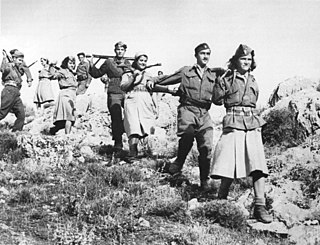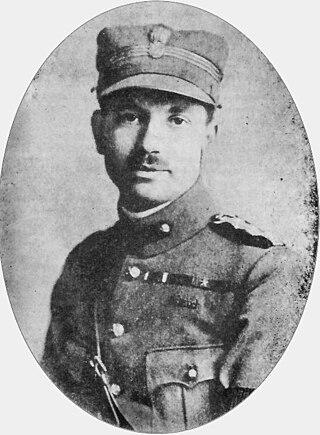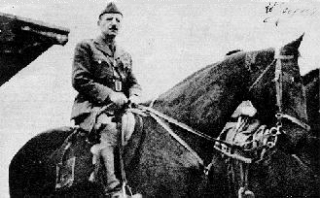A resistance movement is an organized group of people that tries to resist the government or an occupying power, causing disruption and unrest in civil order and stability. Such a movement may seek to achieve its goals through either the use of nonviolent resistance, or the use of force, whether armed or unarmed. In many cases, as for example in the United States during the American Revolution, or in Norway in the Second World War, a resistance movement may employ both violent and non-violent methods, usually operating under different organizations and acting in different phases or geographical areas within a country.

The National Liberation Front (Greek: Εθνικό Απελευθερωτικό Μέτωπο, Ethnikó Apeleftherotikó Métopo was an alliance of various political parties and organizations which fought to liberate Greece from Axis Occupation. It was the main movement of the Greek Resistance during the occupation of Greece. Its main driving force was the Communist Party of Greece, but its membership throughout the occupation included several other leftist and republican groups. ΕΑΜ became the first true mass social movement in modern Greek history. Its military wing, the Greek People's Liberation Army, quickly grew into the largest armed guerrilla force in the country, and the only one with nationwide presence. At the same time, from late 1943 onwards, the political enmity between ΕΑΜ and rival resistance groups from the centre and right evolved into a virtual civil war, while its relationship with the British and the British-backed Greek government in exile was characterized by mutual mistrust, leading EAM to establish its own government, the Political Committee of National Liberation, in the areas it had liberated in spring 1944. Tensions were resolved provisionally in the Lebanon Conference in May 1944, when EAM agreed to enter the Greek government in exile under Georgios Papandreou. The organization reached its peak after liberation in late 1944, when it controlled most of the country, before suffering a catastrophic military defeat against the British and the government forces in the Dekemvriana clashes. This marked the beginning of its gradual decline, the disarmament of ELAS, and the open persecution of its members during the "White Terror", leading eventually to the outbreak of the Greek Civil War.

The Greek People's Liberation Army (Greek: Ελληνικός Λαϊκός Απελευθερωτικός Στρατός, Ellinikós Laïkós Apeleftherotikós Stratós was the military arm of the left-wing National Liberation Front during the period of the Greek resistance until February 1945, when, following the Dekemvriana clashes and the Varkiza Agreement, it was disarmed and disbanded. ELAS was the largest and most significant of the military organizations of the Greek resistance.

The Greek resistance, involved armed and unarmed groups from across the political spectrum that resisted the Axis occupation of Greece in the period 1941–1944, during World War II. The largest group was the Communist-dominated EAM-ELAS. The Greek Resistance is considered one of the strongest resistance movements in Nazi-occupied Europe, with partisans, known as andartes, controlling much of the countryside prior to the German withdrawal from Greece in late 1944.
National and Social Liberation was a Greek Resistance movement during the Axis occupation of Greece. It was founded in autumn 1942 by Colonel Dimitrios Psarros and politician Georgios Kartalis.
Evripidis Bakirtzis, born in Serres, Ottoman Empire, was a Hellenic Army officer and politician. Dismissed from the army twice due to his participation in pro-republican coup attempts and sentenced to death, later during the Axis Occupation of Greece, in World War II he co-founded the National and Social Liberation (EKKA) resistance group along with Dimitrios Psarros and was the military head of the organization. He later joined and was a prominent member of the National Liberation Front (EAM) and its military wing the Greek People's Liberation Army (ELAS). He served as head of the Political Committee of National Liberation (PEEA), a government of Greek Resistance-held territories also called the "Mountain Government", from 10 March to 18 April 1944. He was nicknamed "the Red Colonel", from his pen name in the newspaper of the Communist Party of Greece, the Rizospastis.

Dimitrios Psarros was a Greek army officer, founder and leader of the resistance group National and Social Liberation (EKKA), the third-most significant organization of the Greek Resistance movement after the National Liberation Front (EAM) and the National Republican Greek League (EDES). In 1944, he was executed by Greek communist forces.

The Political Committee of National Liberation, commonly known as the "Mountain Government", was a Communist Party-dominated government established in Greece in 1944 in opposition to both the collaborationist German-controlled government at Athens and to the royal government-in-exile in Cairo. It was integrated with the Greek government-in-exile in a national unity government at the Lebanon conference in May 1944.

Stefanos Sarafis was an officer of the Hellenic Army and Major General in EAM-ELAS), who played an important role during the Greek Resistance.

Athanasios Klaras, better known by the nom de guerreAris Velouchiotis, was a Greek journalist, politician, member of the Communist Party of Greece, the most prominent leader and chief instigator of the Greek People's Liberation Army (ELAS) and the military branch of the National Liberation Front (EAM), which was the major resistance organization in occupied Greece from 1942 to 1945.
Komninos Pyromaglou, was a Greek teacher and politician, and one of the driving forces behind the foundation of the National Republican Greek League (EDES), the second-largest Resistance organization in Axis-occupied Greece during World War II. Drifting to the Left after the war, he became elected to Parliament and wrote extensively on his experiences during the Occupation and the Resistance.

Georgios Kartalis was a Greek politician.

The Greek Civil War took place from 1946 to 1949. The conflict, which erupted shortly after the end of World War II, consisted of a communist-dominated uprising against the established government of the Kingdom of Greece. The opposition declared a people's republic, the Provisional Democratic Government of Greece, which was governed by the Communist Party of Greece (KKE) and its military branch, the Democratic Army of Greece (DSE). The rebels were supported by Yugoslavia and the Soviet Union. With the support of the United Kingdom and United States, the Greek government forces ultimately prevailed.
The National Bands Agreement was an agreement concluded on 5 July 1943 at the village of Liaskovo, between the British military mission to occupied Greece and the three main Greek Resistance organizations, EAM-ELAS, EDES and EKKA. Its aim was to coordinate the actions of the Resistance movement in Greece, including the establishment of a joint headquarters under the aegis of the British GHQ Middle East.
The Feneos Executions is the name given to a series of killings committed by the Greek People's Liberation Army (ELAS) resistance group, and especially by its secret police OPLA, in the Feneos area of Corinthia, Greece, during the first stages of the Greek Civil War, while the country was still occupied by the Axis Powers.

The International Federation of Resistance Fighters – Association of Anti-Fascists also known by its French initials FIR was started putiatively, organization of veterans of the anti-Axis resistance fighters, partisans, 'members of the anti-Hitler coalition'. During the Cold War, the officialy or self stated work of the FIR was closely connected with issues of 'peace', 'disarmament', and 'understanding and cooperation of countries of different political systems'. The FIR claimed to 'give former resistance fighters a voice against the policy of military confrontation and the real threat of war', and that 'member organizations in West and East took numerous initiatives to end the policy of confrontation'.
The Lebanon conference was held on May 17–20, 1944, between representatives of the Greek government in exile, the pre-war Greek political parties, and the major Greek Resistance organizations, with the British ambassador Reginald Leeper in attendance. The conference occurred after an anti-monarchist mutiny among the Greek military the previous month. PM Georgios Papandreou's policy was to create a National Unity government with the participation of the communist-dominated EAM. Finally there was a partial agreement, though tensions and disagreements remained.
Operation Animals was a World War II mission by the British Special Operations Executive (SOE), in cooperation with the Greek Resistance groups ELAS, Zeus, EDES, PAO and the United States Army Air Force. The operation took place between 21 June and 11 July 1943 and included an organized campaign of sabotage in Greece, to deceive the Axis Powers into believing that Greece was the target of an Allied amphibious landing, instead of Sicily. Despite the mission's success, the Greek civilian population suffered from mass reprisals and British intervention into the internal affairs of the Greek resistance exacerbated the tensions between its various components.









